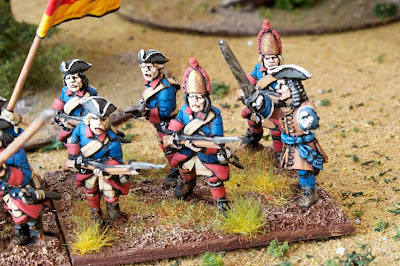The Jönköpings regiment, as were most of the units in Karl's main
army, were indelta infantry. As the name suggests, they were raised in
the town and county of Jönköping, located in south central Sweden at the
bottom of Lake Vättern. As today, Jönköping County is a populous area
so they could raise a regiment as a county where normally an entire
province did so. The province in question was so populous, in fact, that
a second county in it, Kronoberg County, also raised a regiment. There
was talk in the 17th century of amalgamating both regiments into a
Smaland infantry regiment, but this never came to pass.
The
Jönköpings regiment started the Great Northern War in Sweden's North
German posession of Pomerania and participating in the Holstein campaign
in 1700. In 1702, it went to Poland to join the King's Army (which had
arrived there from its victorious campaign in Russia) and remained with
it until its surrender at Poltava. After Poltava, the Jönköpings
regiment was reraised, fought in Skane and was then sent to Germany
again, where it ended it second life at Stralsund when that city
surrendered to the Allies in 1715. The regiment was then raised a final
time to participate in the abortive 1718 Norwegian campaign.
In the battle of Poltava, the Jönköpings regiment - which was down
to a single battalion in strength by then - started out as the rear unit
in the column of General Sparre on the extreme left of the advance
through the redoubts. In the confusion of night and unclear orders, the
Jönköpings and the regiment in front of it (Närke-Värmlands) somehow
veered of to the right and got implicated in General Roos' attacks on
various redoubts. They stayed with Roos throughout the rest of the
battle, being chased away from the main infantry advance and eventually
ending up surrendering in sight of Poltava itself. They did not see
action in the main fight later that day.
The
uniforms of the Jönköpings regiment are the basic blue Swedish coat with
red facings, leather vests and breeches and red stockings. In 1700 the
unit had red lined Karpus, but these were replaced by white braided hats
in 1702, so I have opted for the latter to represent the unit as at
Poltava. There is no information on the grenadiers' headwear, so I have
given them the iconical mitres.


